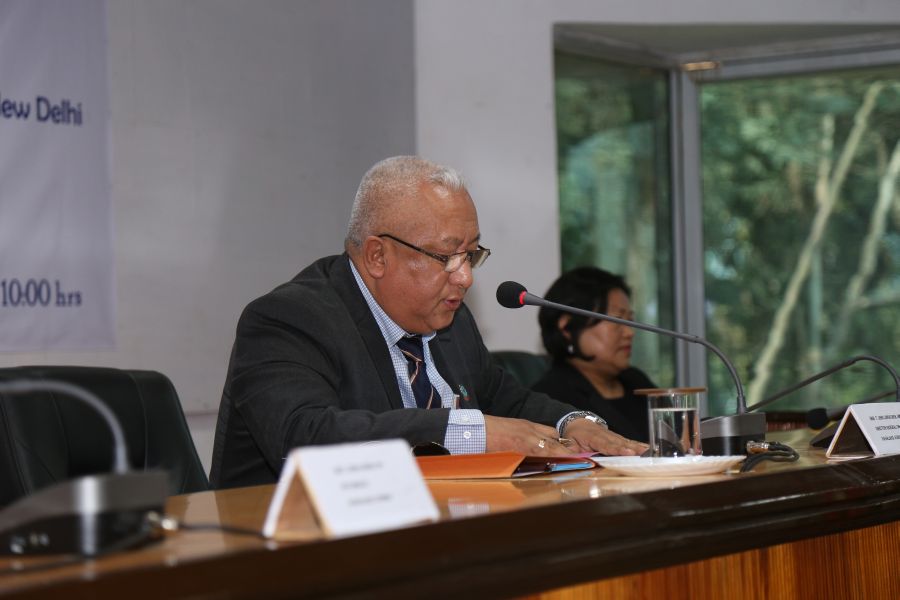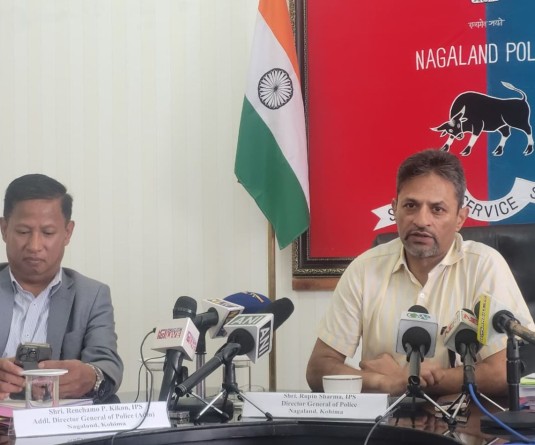The evolving challenges of human trafficking in Nagaland

DGP Nagaland, T John Longkumer, addressing the ‘State Level Conference on Anti-Human Trafficking’ held at Police Complex, Chümoukedima, on March 4. (Photo Courtesy: Nagaland Police)
• A person goes missing in Nagaland every fourth day
• 13% of missing persons have reportedly been trafficked
Morung Express News
Dimapur | March 4
Nagaland has been identified as one of the leading points of origin for human trafficking in the country, with the evolving nature of this problem presenting new challenges. The North East Region remains one of the most vulnerable regions in the country due to disparities in wealth and lack of employment
Reportedly, in Nagaland a person goes missing every fourth day and out of the 87 cases of missing persons registered in the past three years (2017-19) from different districts of the state, 83% are below the age of 18 years. And 13% of the missing persons in Nagaland have been reportedly trafficked.
These figures were shared by DGP Nagaland, T John Longkumer, at the ‘State Level Conference on Anti-Human Trafficking’ held at Rhododendron Hall, Police Complex, Chümoukedima on March 4.
The conference was organized by the Nagaland Police and supported by the Ministry of Home Affairs, Women Safety Division.
The state police chief said Nagaland Police has devised several mechanisms including formation of anti-human trafficking cells in every district with a senior police officer as the designated head, and implementation of monitoring tools like the anti-human trafficking portal and use of social media to reach out to different sections of society.
Longkumer said the state Police is also utilizing legal provisions of the Indian Penal Code as per the provisions of the Criminal Law (Amendment) Act 2013, the Immoral Traffic (Prevention) Act 1956, Transplantation of Human Organ Act of 1994, the Juvenile Justice (Care and protection of children) Act 2000, and the Protection of Children from Sexual Offence Act (POSCO), 2012.
Threat remains potent
The threat however remains potent, Longkumer stated. He informed that the modus operandi of the trafficker is ever evolving.
“From onsite recruitment the focus is changing to recruitment over social media. Instead of physical locations the Dark Net is used for auctioning ‘slaves',” the DGP informed. He added that the use of technology and the transnational nature of the offence are major challenges which the State must rise up to meet.
The DGP also informed that India is one of the most affected nations, being both a destination as well as place of origin for trafficked people. Longkumer said as per 2016 NCRB data, 15,379 people were trafficked in India.
While informing that the war against human trafficking is being fought on three principles—prevent, prosecute and protect, Longkumer urged all the stakeholders to come together to also include a fourth p—partnership.
“Each of us have been micro-managing the problem efficiently, it is now time to macro-manage it effectively”, he added.
Ensuring survivors’ rights
The three Resource persons of the conference included Asungbe, legal cum probation officer, District Child Protection Unit (DCPU), Peren; T Chubayanger, Project Officer, Directorate of Labour, Kohima; and Yanbemo Ngullie, Panel Lawyer, District Legal Services Authority (DLSA), Dimapur.
Asungbe who spoke on ‘Recovery, Rescue and Rehabilitation’ dwelled on various aspects and guidelines to be followed during a rescue operation, especially in regard to women victims. He said the search/rescue party must have women police officers (ITPA s-15) and NGOs can also be incorporated during the search and rescue proceedings.
“Survivors must be segregated from the accused and the suspects. The rights of the rescued persons must be ensured at all times,” he added.
“The police personnel’s role is extremely important in post-rescue, since this stage represents the first point of contact between the survivor and the society in the form of police personnel. As such, within post-rescue, the first response of the police personnel to the survivors has far-reaching consequences”, Asungbe said.
Forced labour & stringent laws
Chubayanger spoke on ‘Forced Labour and Modern Slavery’ and highlighted the International Labour Organisation’s (ILO) Abolition of Forced Labour Convention, 1957 (No. 105), which was ratified by India on May 18, 2000. He also said Article 23 of the Constitution of India deals with prohibition of traffic in human beings and forced labour.
He stated that slavery is now less about people literally owning other people and more about being exploited and completely controlled by someone else, without being able to leave.
Chubayanger said the forms of modern slavery include forced labour, debt bondage or bonded labour, human trafficking, descent-based slavery, child slavery, forced and early marriage
He also informed that the Nagaland Government Servants Conduct Rules, 1968, Rule 4-B prohibits employment of children below 14 years of age by government servants.
Yanbemo Ngullie in his presentation said the laws for human trafficking must be strengthened to meet all the requirements for preventing human trafficking.
“People who are in poverty line across the country must be made aware about human trafficking and its consequences in order to prevent them from becoming victims. Many national and international seminars and conferences can be conducted across the country so that the people and the government can join hands to prevent human trafficking,” he said.
He also stressed on the roles of stakeholders including government, NGOs and media in combating human trafficking through awareness and advocacy. Besides police officers, a host of government officials from other departments and NGO representatives attended the conference.




